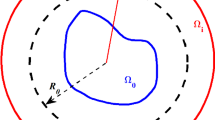Abstract
We derive optimal a priori error estimates for discontinuous Galerkin (dG) time discrete schemes of any order applied to an advection–diffusion model defined on moving domains and written in the Arbitrary Lagrangian Eulerian (ALE) framework. Our estimates hold without any restrictions on the time steps for dG with exact integration or Reynolds’ quadrature. They involve a mild restriction on the time steps for the practical Runge–Kutta–Radau methods of any order. The key ingredients are the stability results shown earlier in Bonito et al. (Time-discrete higher order ALE formulations: stability, 2013) along with a novel ALE projection. Numerical experiments illustrate and complement our theoretical results.


Similar content being viewed by others
References
Akrivis, G., Makridakis, Ch.: Galerkin time-stepping methods for nonlinear parabolic equations. M2AN Math. Model. Numer. Anal. 38(2), 261–289 (2004)
Badia, S., Codina, R.: Analysis of a stabilized finite element approximation of the transient convection–diffusion equation using an ALE framework. SIAM J. Numer. Anal. 44(5), 2159–2197 (2006). (electronic)
Bangerth, W., Hartmann, R., Kanschat, G.: Deal. II—a general-purpose object-oriented finite element library. ACM Trans. Math. Softw. 33(4):Art. 24, 27 (2007)
Boffi, D., Gastaldi, L.: Stability and geometric conservation laws for ALE formulations. Comput. Methods Appl. Mech. Eng. 193(42–44), 4717–4739 (2004)
Bonito, A., Kyza, I., Nochetto, R.H.: Time-discrete higher order ALE formulations: computational investigation (In preparation)
Bonito, A., Kyza, I., Nochetto, R.H.: Time-discrete higher order ALE formulations: stability. SIAM J. Numer. Anal. 51(1), 577–604 (2013). doi:10.1137/120862715
Brenner, S.C., Scott, L.R.: The Mathematical Theory of Finite Element Methods. Texts in Applied Mathematics, vol. 15, 3rd edn. Springer, New York (2008)
Chrysafinos, K., Walkington, N.J.: Lagrangian and moving mesh methods for the convection diffusion equation. M2AN Math. Model. Numer. Anal. 42(1), 25–55 (2008)
Ciarlet, Ph.G.: The finite element method for elliptic problems. Studies in Mathematics and its Applications, vol. 4. North-Holland Publishing Co., Amsterdam (1978)
Donéa, J., Giuliani, S., Halleux, J.P.: An arbitrary Lagrangian–Eulerian finite element method for transient dynamic fluid–structure interactions. Comput. Methods Appl. Mech. Eng. 33(1–3), 689–723 (1982)
Evans, L.C., Gariepy, R.F.: Measure theory and fine properties of functions. In: Studies in Advanced Mathematics. CRC Press, Boca Raton (1992)
Farhat, Ch., Geuzaine, Ph., Grandmont, C.: The discrete geometric conservation law and the nonlinear stability of ALE schemes for the solution of flow problems on moving grids. J. Comput. Phys. 174(2), 669–694 (2001)
Farhat, Ch., Lesoinne, M., Maman, N.: Mixed explicit/implicit time integration of coupled aeroelastic problems: three-field formulation, geometric conservation and distributed solution. Internat. J. Numer. Methods Fluids, 21(10), 807–835 (1995). Finite element methods in large-scale computational fluid dynamics (Tokyo, 1994)
Formaggia, L., Nobile, F.: A stability analysis for the arbitrary Lagrangian Eulerian formulation with finite elements. East–West J. Numer. Math. 7(2), 105–131 (1999)
Formaggia, L., Nobile, F.: Stability analysis of second-order time accurate schemes for ALE-FEM. Comput. Methods Appl. Mech. Eng. 193(39–41), 4097–4116 (2004)
Gastaldi, L.: A priori error estimates for the arbitrary Lagrangian Eulerian formulation with finite elements. East–West J. Numer. Math. 9(2), 123–156 (2001)
Geuzaine, Ph., Grandmont, C., Farhat, Ch.: Design and analysis of ale schemes with provable second-order time-accuracy for inviscid and viscous flow simulations. J. Comp. Phys. 191(1), 206–227 (2003)
Guillard, H., Farhat, Ch.: On the significance of the geometric conservation law for flow computations on moving meshes. Comput. Methods Appl. Mech. Eng. 190(11–12), 1467–1482 (2000)
Hirt, C.W., Amsden, A.A., Cook, J.L.: An arbitrary Lagrangian–Eulerian computing method for all flow speeds. J. Comput. Phys. 14(3), 227–253 (1974). J. Comput. Phys., 135(2), 198–216 (1997). With an introduction by L. G. Margolin, Commemoration of the 30th anniversary of J. Comput. Phys
Hughes, T.J.R., Liu, W.K., Zimmermann, T.K.: Lagrangian–Eulerian finite element formulation for incompressible viscous flows. Comput. Methods Appl. Mech. Eng. 29(3), 329–349 (1981)
Jamet, P.: Galerkin-type approximations which are discontinuous in time for parabolic equations in a variable domain. SIAM J. Numer. Anal. 15(5), 912–928 (1978)
Nobile, F.: Numerical approximation on fluid–structure interaction problems with application to haemodynamics. PhD thesis, École Polytechnique Fédérale de Lausanne (2001)
Ortegaa, L.A., Scovazzi, G.: A geometrically-conservative, synchronized, flux-corrected remap for arbitrary Lagrangian–Eulerian computations with nodal finite elements (Submitted)
Quarteroni, A., Tuveri, M., Veneziani, A.: Computational vascular fluid dynamics: problems, models and methods. Comput. Visual. Sci. 2(4), 163–197 (2000)
Stein, E.M.: Singular Integrals and Differentiability Properties of Functions. Princeton Mathematical Series, vol. 30. Princeton University Press, Princeton (1970)
Thomée, V.: Galerkin finite element methods for parabolic problems. Springer Series in Computational Mathematics, vol. 25, 2nd edn. Springer, Berlin (2006)
Acknowledgments
The authors would like to express their gratitude to W. Bangerth and G. Kanschat for participating in several discussions regarding the implementation of dG in time with deal.II [3].
Author information
Authors and Affiliations
Corresponding author
Additional information
A.B. was partially supported by NSF Grant DMS-0914977 and by Award No. KUS-C1-016-04, made by King Abdullah University of Science and Technology (KAUST). I.K. was partially supported by the European Social Fund (ESF)-European Union (EU) and National Resources of the Greek State within the framework of the Action “Supporting Postdoctoral Researchers” of the Operational Programme “Education and Lifelong Learning (EdLL)” and by NSF Grants DMS-0807811 and DMS-0807815. R.H.N. was partially supported by NSF Grants DMS-0807811 and DMS-1109325.
Rights and permissions
About this article
Cite this article
Bonito, A., Kyza, I. & Nochetto, R.H. Time-discrete higher order ALE formulations: a priori error analysis. Numer. Math. 125, 225–257 (2013). https://doi.org/10.1007/s00211-013-0539-3
Received:
Revised:
Published:
Issue Date:
DOI: https://doi.org/10.1007/s00211-013-0539-3




